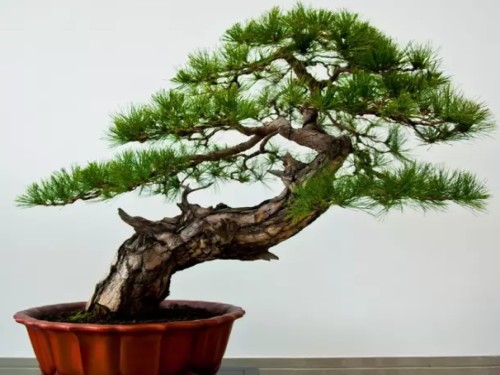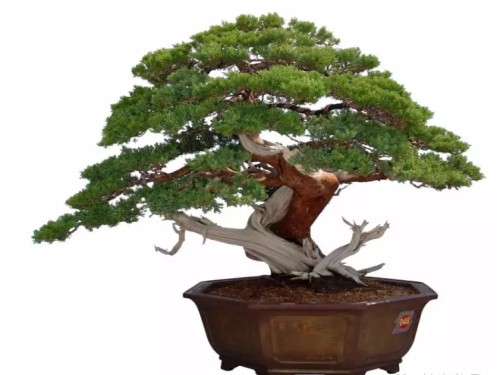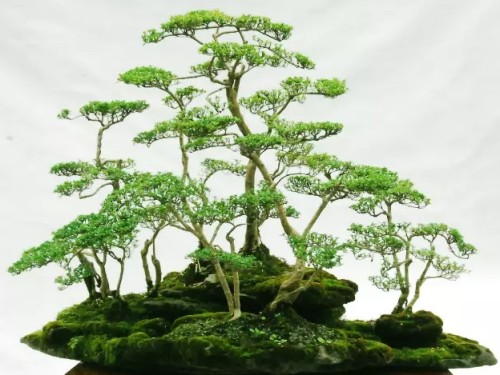The production method of Su Pai Bonsai
This provides sufficient material conditions for bonsai production. Su-style bonsai art has a long history and has its unique modeling structure and artistic style. it is one of the main schools of Chinese bonsai. Su-style bonsai is one of the excellent traditional arts of Han nationality and a treasure of garden art.
The development of Suzhou bonsai has superior natural, historical and cultural conditions. The scenery here is clear and beautiful, which provides the best model for the creation of bonsai. One of the features of Suzhou bonsai is the true performance of the natural scenery around Taihu Lake. That kind of distant forest, distant mountains, elegant and elegant artistic conception. And because of the convenient land and water transportation in the temperate zone, the variety of plants available for bonsai production is extremely rich. Suzhou also produces rocks suitable for bonsai production, such as transparent and exquisite Taihu Lake stone, first-class stone Kunshan stone, stalactite, sand stone and so on. it provides sufficient material conditions for bonsai production.

Su style bonsai is composed of five parts: the first is the root, the second is the stem, the third is the node, the fourth is the new branch, the fifth is the top. As long as the five parts are processed and shaped separately, they can become a fresh work of art.
1. Tigen
According to the distribution of the root, the root system is raised on the soil surface and placed in the four directions. Panqu anger starts from the basin surface, and the plate root is also better exposed on the soil surface, which can be positive, oblique and lie down. "the head should be slanted, and the foot should be lined up", so that it can reach "hanging roots and showing claws". To show the ancient. Root lifting should be carried out gradually year by year, and should not be mentioned too much at one time, so as not to damage the roots and affect the growth. If the root is thin, do not put forward the soil surface, otherwise the wind and rain for a long time, the sun will all die after freezing. You can continue to cultivate and raise roots, and it is not too late to raise roots after a certain degree of coarseness. If the bonsai has no thick roots, it cannot be exposed to the soil.
2. Take the bend
Generally speaking, most of the trees are upright, and they need to be climbed into several bends and fixed. This is called "taking bends". There is a rule to take a bend, that is, there is a straight in the bend, and the top root is opposite to each other. It means that the center of gravity of the plant should not go beyond the basin to maintain stability and facilitate growth (except for special formats). Don't take the corner too prominently or too beside the point. Take the first bend, called "seat bottom bend", also known as "unearthed bend", the bend can be left, right, backward, but should not bend forward, this is also a basic knowledge.
3. Donton Festival
There are usually two things that happen during the Dayton Festival. First, after taking the bend on the pot, the branches that are useless to the shape will be sawed off. When sawing branches, there should be short stakes according to the shape of the trees, not all of them. The second is to cut short the thin, long, tall, unbranched and difficult-to-form trunk from the ground before plastic surgery, so that it can sprout new branches. Or there are several small trunks on the root, leaving only one trunk, cutting off the rest, and replacing the trunk with lateral branches, which can better show the tenacious vitality of the tree of nature. This is also called "Dayton", but the specific approach is different.
4. Make a film
All the main branches, branches, and three branches and four branches of the trunk are made with leaves into "dumpling head shape" or "cloud sheet shape" and other tree slices, requiring the dry pieces to be plump, slightly higher in the middle, round and thin and flat, which is called "making slices". The "frontal branch" (the human side of the branch) is not allowed to appear on the trunk, let alone make another piece on the frontal branch. The film is made mainly by cutting and supplemented by pruning. If you use brown rope to tie into flat and thin slices, it is very labor-consuming and time-consuming, and ordinary people also lack this kind of skill, so they mainly trim the core pieces. Generally do on the main branch, one piece, or there is a piece, the main branch should be from the trunk hunchback direction, not from the inner bend. In the pruning to do the film, a taboo "pole branch", that is, left and right to make a piece, forming a straight line, there is no difference between length and length. The second taboo "face branch", in the trunk of the branch, there is a straight forward, as if to pierce the eye of the viewer, it is not elegant, it should be sawed flat, it is better to lose one branch than to leave it as an eyesore. Pay attention to the branches behind the trunk, which is called "back wall branch". The back wall branch can make bonsai trees rich and three-dimensional.
5. Top off
It is required that the top root is relative to each other, and the top plate should not exceed the area of the pelvic floor (except for special ones). Pay attention to the appropriate movement, and pay more attention to the effect of looking up. The crown is tilted 1-2 cm backward, do not bow. The size of the top can only account for the second and third of the whole branch, and should not be larger than the branch. Specifically, it is required to be big and small, or symmetrical, not parallel up and down, or a single branch does not echo each other, one branch and other branches should be related to each other, and the branches should be hierarchical, and each piece should be stable and tidy, not covering each other, and not overlapping each other. Pay special attention to the branches can not be even, should be odd, from the overall point of view, dynamic but not rigid. If the branches of the cliff-style bonsai should be wide on top and narrow on the bottom, they appear to be particularly vigorous and vigorous.
Time: 2019-06-04 Click:
- Prev

Lingnan School Bonsai Making Technique
Lingnan bonsai creation, more local materials, the selection of subtropical and tropical evergreen fine leaf species, generally known as Guangzhou tree stumps, as many as dozens of varieties. Lingnan bonsai is one of the excellent traditional arts of Han nationality, a treasure of garden art. Lingnan people, especially Guangzhou people, love bonsai
- Next

Sichuan style bonsai making techniques
Sichuan style bonsai is one of the five traditional schools of Chinese bonsai, deeply rooted in the magnificent and beautiful Bashan Shu River. The bonsai making skills represented by Chengdu area are the foundation and core of Sichuan style bonsai making skills. Sichuan basin artist, devoted to enlightenment, careful observation, production skills
Related
- Fuxing push coffee new agricultural production and marketing class: lack of small-scale processing plants
- Jujube rice field leisure farm deep ploughing Yilan for five years to create a space for organic food and play
- Nongyu Farm-A trial of organic papaya for brave women with advanced technology
- Four points for attention in the prevention and control of diseases and insect pests of edible fungi
- How to add nutrient solution to Edible Fungi
- Is there any good way to control edible fungus mites?
- Open Inoculation Technology of Edible Fungi
- Is there any clever way to use fertilizer for edible fungus in winter?
- What agents are used to kill the pathogens of edible fungi in the mushroom shed?
- Rapid drying of Edible Fungi

